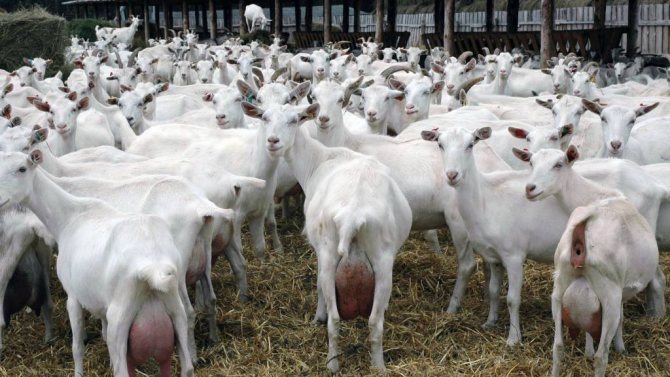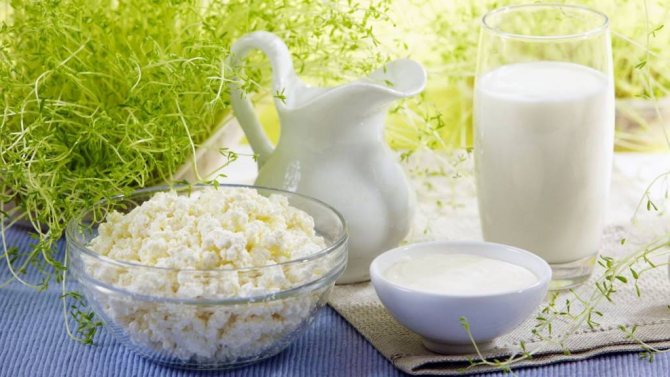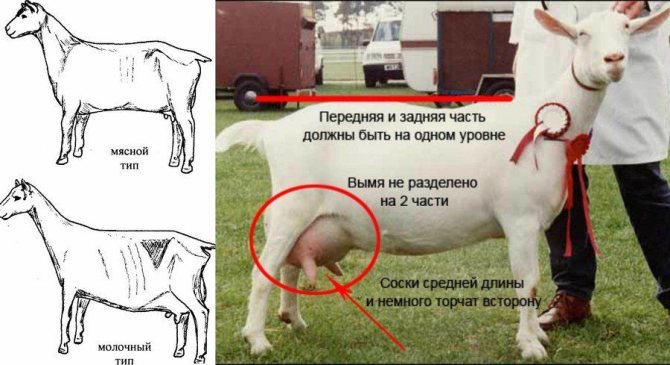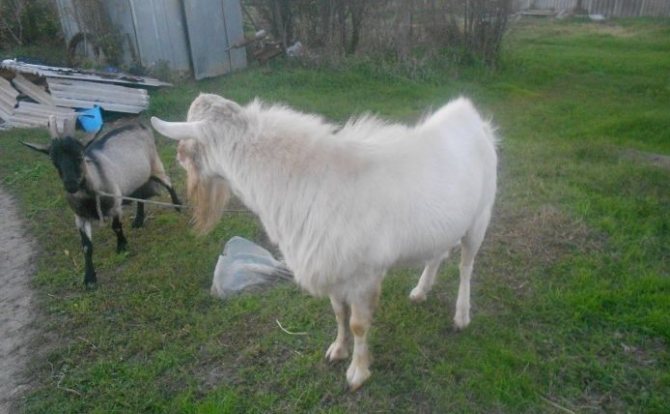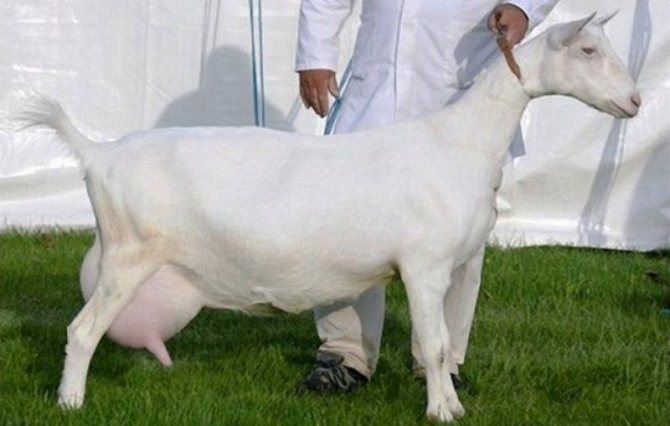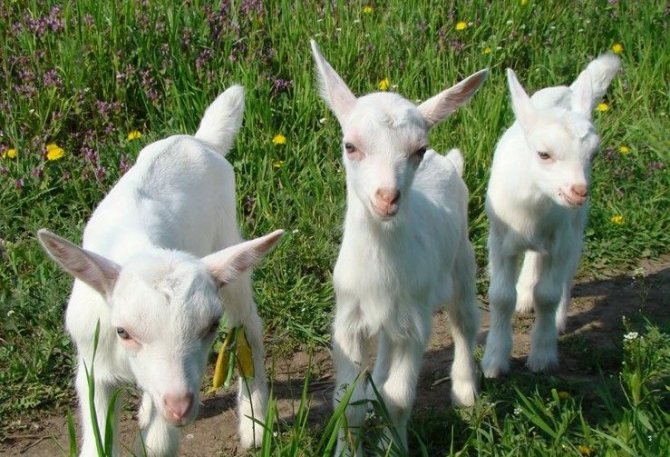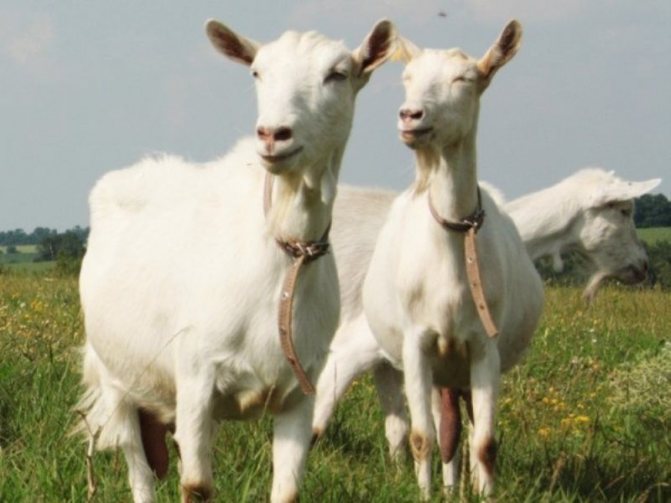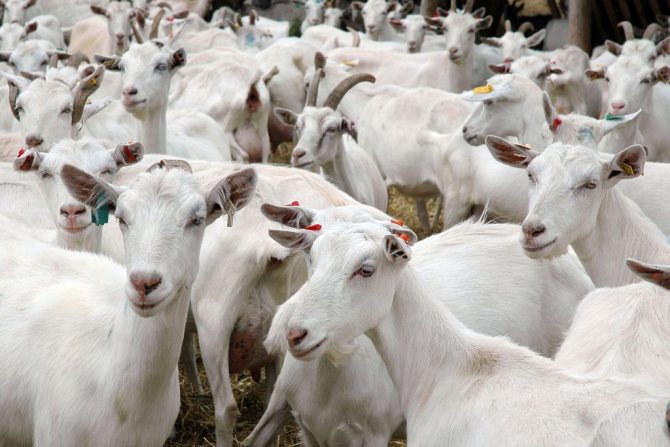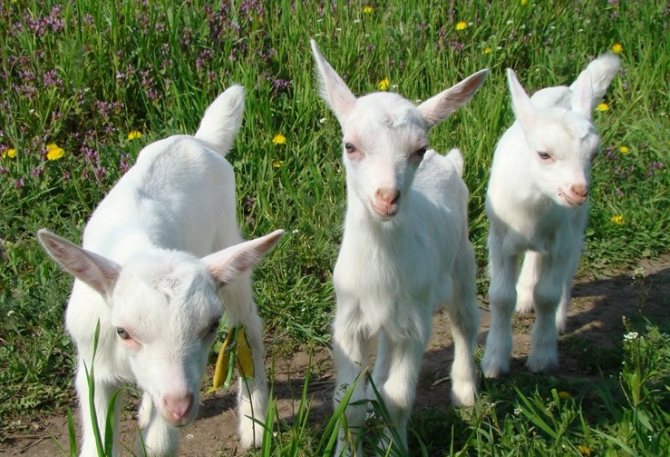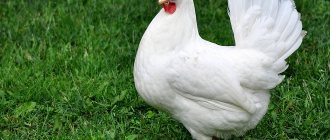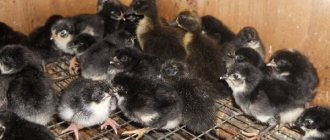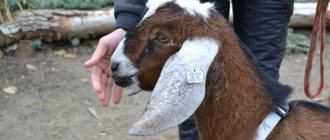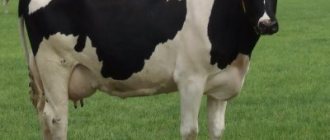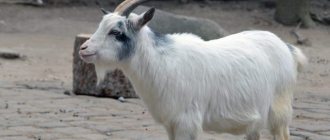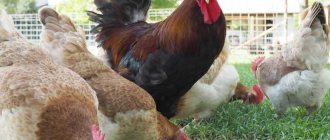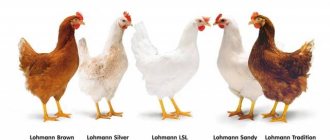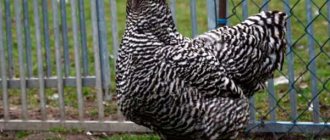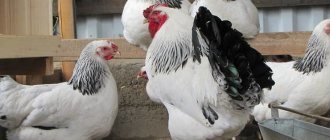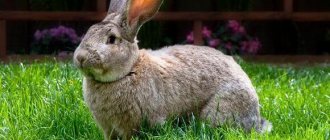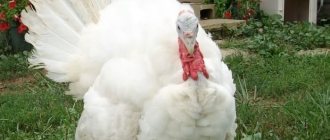The name of the breed is given in honor of the small Swiss town of Saanen, in terms of the quantity and quality of milk, they are one of the best goats. But this applies only to purebred representatives of the Saanen breed, and such individuals can only be purchased from real breeders or breeding farms. There is no exact data on the pedigree of the breed, ordinary shepherds derived it on the basis of a personal selection of the best representatives, all other individuals were not used for the tribe.
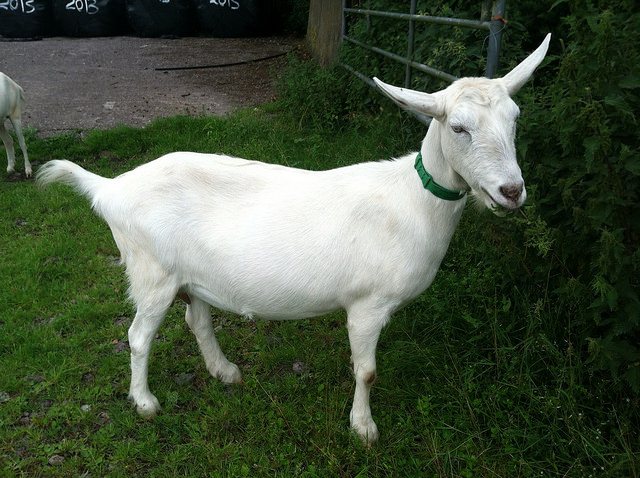
Saanen goat
Origin story
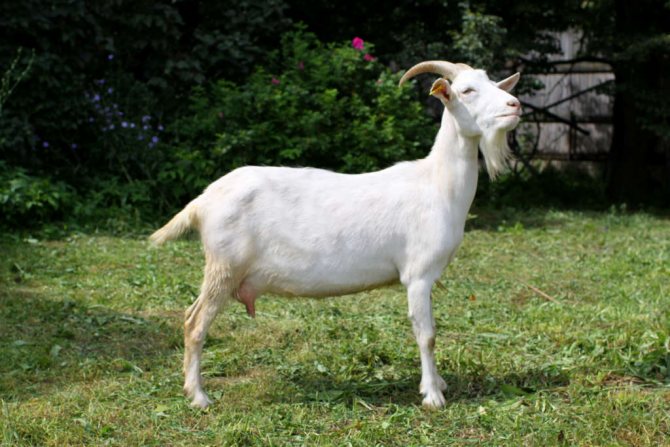

The breed got its name in honor of the town of Saanen (Switzerland). This breed is considered one of the best in terms of milk production.
The breed does not have an exact pedigree - goats were bred by folk selection in the 19th century. The “breeders” were ordinary shepherds grazing livestock in the Swiss Alps.
The breed, attracting breeders with its milk yield, quickly spread throughout the world.
Today there are several lines of the Zaanen breed:
- American;
- Dutch;
- British;
- white;
- Russian.
In Russia, the first Saanen goats appeared at the beginning of the 20th century. The batch of goats brought to the USSR numbered only 20 individuals, but it is with them that the history of the Zaanen breed in Russia begins.
Habitat
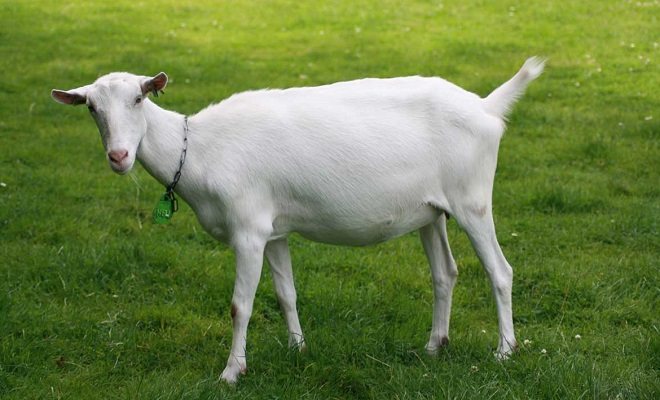

Saanen goats come from the "dairy region" - the Swiss Alps. This breed is distinguished by good acclimatization abilities - animals easily adapt to life in different regions of Russia and in the near abroad.
They are especially bred in the south and west of the Russian Federation, but they can be grown in the north as well - the main thing is to provide good care and maintenance. This breed is also popular in Moldova and Belarus.
Description of the breed
Photo:
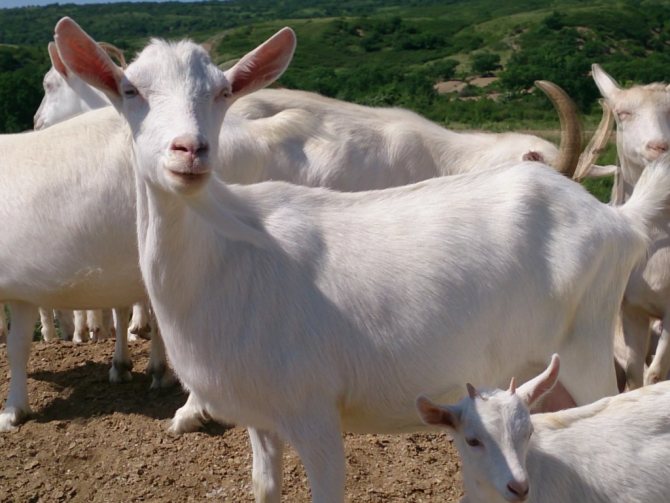

By one appearance of Saanen goats, a specialist will immediately determine a highly yielding breed. These goats are close to ideal in their measurements. White animals with strong bones look elegant - as befits high-yielding dairy goats.
Exterior
Males and females of Saanen goats are hornless. The Zaanen people look like a true standard of the domestic goat. They have a well-developed strong body and a well-formed skeleton.
Moreover, in their appearance there is no coarseness or massiveness, the females look cute and neat.
Features of the exterior of Saanen goats:
- The body is wide, elongated.
- The head is beautiful, sophisticated sculpting, the muzzle is narrow.
- Ears are oblong, erect, slightly inclined to one side.
- The muscles in the thighs are poorly developed.
- The udder is large, pear-shaped.
- The nipples are well developed.
- The hooves are light yellow.
Every goat has a beard. Sometimes it also occurs in females. The standard does not allow the ears to be saggy. But "earrings" - skin growths on the neck, are not considered a defect, they can be in purebred and outbred goats.
Experienced goat breeders prefer to remove growths to avoid injury.
In the last century, it was believed that the main distinguishing features of the Saanen breed were its snow-white color and hornlessness.
But then the standards changed. Today, only 3/4 of the individuals are hornless. Earlier it was believed that horns are evil for a gregarious breed, since females can, by sorting out the relationship, inflict injuries on each other.
But it was established by the breeders that if only hornless individuals are bred, infertility and hermaphroditism appear in subsequent generations.
Therefore, many farmers today leave horned individuals. And in order to facilitate the care of animals, the horns of the young are burned.
Size and weight
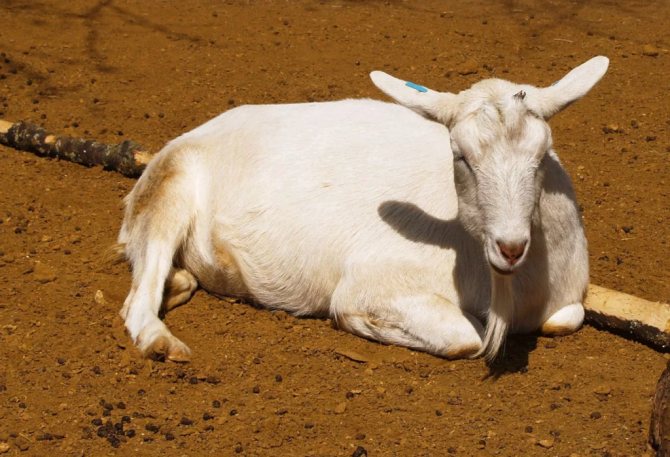

The maximum weight of Saanen goats is 55 kg. The goats are much larger - they can weigh up to 80 kg. These goats are the largest of the dairy breeds.
Weight of kids: newborn goats / kids - 3.5 / 4.5 kg; 2 month old goats / kids - 9-10 / 11-12 kg.
Weight gain from birth to 2 months allows you to define this breed as early maturing. The increase per day is 160 g.
Saanen goat parameters:


We choose according to merits
Goats of the Saanen breed, like all living things on earth, have pros and cons. Naturally, there are much fewer disadvantages than advantages. Negative reviews refer to males.
A goat weighing more than 85 kg is often aggressive, dangerous to others due to its quick-tempered nature. He actively protects the territory not only from other animals, but people can also become the object of aggression. In all other respects, the breed is worthy of respect:
- The taste of milk, meat obtained from the keeping of thoroughbred animals is pleasant. Has a creamy taste.
- Young meat is tender, tasty, juicy. Refers to a dietary type.
- Feeding, maintenance is simple. There are no special instructions. Standard maintenance requirements: clean barn, feeder, drinker.
- In any region, it will adapt to weather and climatic conditions.
- The fat content of the milk is high. It is allowed to give to children from the moment of birth. Does not give an allergic reaction. The only caveat: children under 2 years old are diluted.
- Young growth grows and develops faster than other breeds. The litter for the life cycle of the female is up to 25 babies.
- The lactation period is longer than that of other thoroughbreds. Reaches 10-11 months. The amount of milk increases after the first lambing. Productivity decreases only by the age of 6 years of an adult.
A Saanen goat can bring up to 10 liters per day. Cases have been recorded when, with proper feeding and care, one breeding uterus produced more than 1 ton of milk. The resulting product becomes the basis for cheese making, cottage cheese and other fermented milk products.
Interesting fact! Breeding Zaanen goats, like Nubian goats, in our country is fraught with the only difficulty: you can buy a purebred individual only in a nursery, of which there are few. It's easier to find a cross between the two. Also, the Russian breed is often confused with the Zaanen breed. They are 75% similar in appearance.
Testimonials
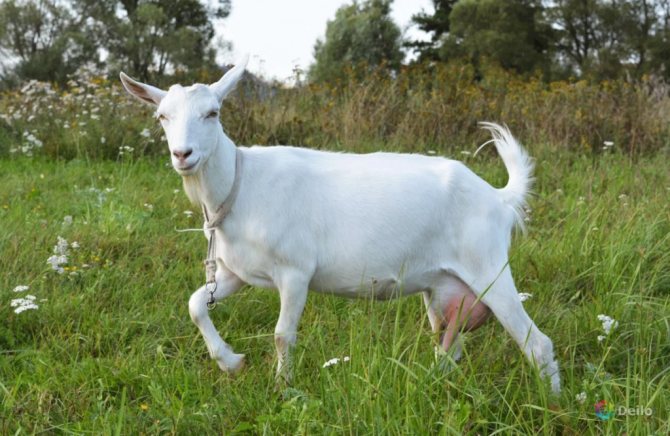

According to the owners, the pluses of the breed include:
- High milk yield. After the first lambing, females give 700 l / year.
- High fertility. A herd of 100 heads gives 180-250 kids.
- Long lactation. The goat gives milk 11 months a year.
- Fast weight gain.
- High fat content of milk.
- High adaptive abilities.
- They are excellent breeding material. Used to improve other breeds, to increase milk production.
- They can graze on difficult terrain - in mountains, ravines, etc.
- The meat of three-month-old goats is good for food.
Given the excellent dairy characteristics, all the disadvantages that exist can be easily forgiven for Saanen goats:
- clubfoot;
- lop-assed;
- developed saber fence (defect in the exterior associated with the setting of the legs);
- underdevelopment of the muscles in the thigh area.
Also, the breed is "accused" of "Roman nose" and oversized goats.
All these flaws are not an obstacle to the successful breeding of highly productive goats. It is this breed that farmers choose to get good yields.
Russian white goat breed
The breed was bred in the northwest of Russia, and then spread to other countries. Goats also belong to the dairy breed, per year one individual gives up to 500 liters of milk of 4.5% fat.These are fairly large individuals with a well-developed physique.
The color of the goat, judging from the name, is white. It has a small body and a small head with large horns that are bent back. They reproduce well, which can also be called an advantage. The mass of an adult goat reaches 50 kilograms, a male can weigh up to 70 kilograms. The breed reproduces well, fertility is about 240%.
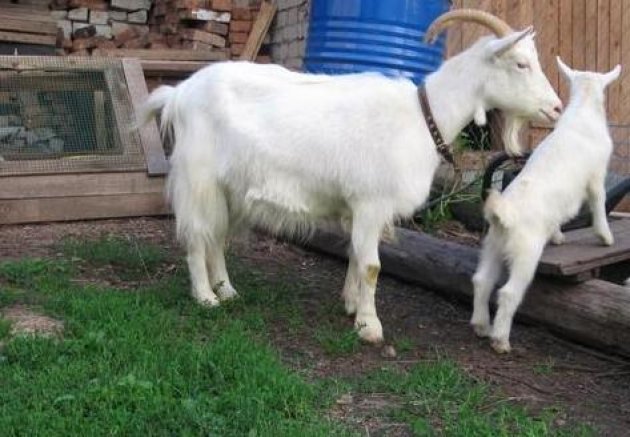

In the photo a goat of a dairy Russian white breed
Productivity
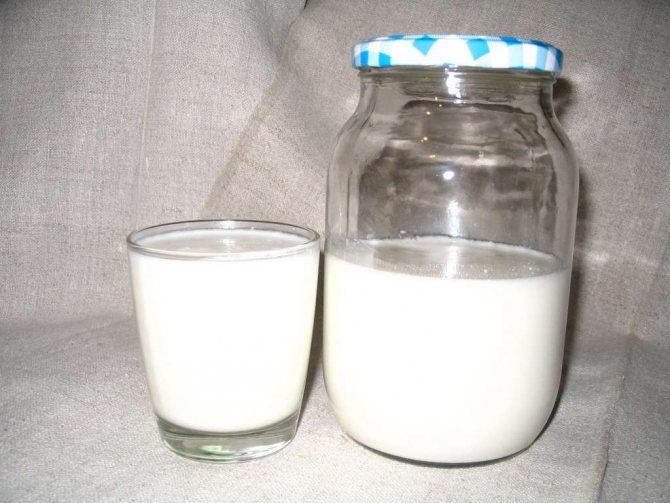

Goat milk is an ideal raw material for making cottage cheese, cheese and butter. Milk yield depends on the quality of feeding and keeping the animals.
Zaanen goats are bred for milk production, so the main thing that breeders are interested in is milk productivity. Also important are such points as the quality of the milk and the conditions of detention.
Zaanen goat milk is a kind of standard for dairy products. It is tasty, practically does not smell anything - it has no extraneous odors. Its fat content is 4-4.5%. Daily milk yield - 3.5-8 liters.
Annual milk yield:
- Average rates for Russia are 600-700 l / year.
- Under ideal conditions of keeping and enhanced diet - 1200 l / year.
- The record set by the Saanen breed is 2400 l / year. This result was achieved in the homeland of the breed - in Switzerland.
Milk production is calculated based on the annual lambing. There is less milk before lambing. The more lambing, the higher the milk yield of the goat.
The maximum milk yield is observed after the fourth lambing. During this period, females can feed up to 2000-2500 liters of milk. The weight of the annual milk yield is 20 times more than the goat's own weight.
How and what to feed?
We recommend reading our other articles
- Chestnut honey and its properties
- The best early grape varieties
- Chickens of the Maran breed - description and productivity
- Pickled Green Tomato Recipes
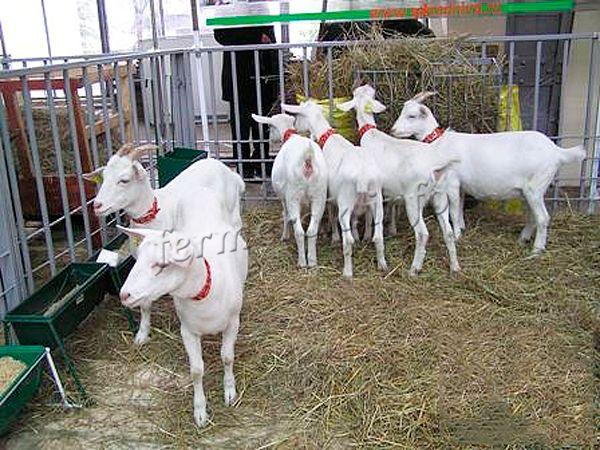

Feeding the Saanen goats
The peculiarity of the diet is that the breed prefers grass and hay only from leguminous and cereal grasses. Hay from herbs may refuse to use. Proceeding from this, it is necessary to choose the place of grazing of the animal or specially sow it in advance with similar plants.
In winter, birch, linden, oak, willow brooms can be offered to the Zaanen breed as delicacies. The grain is given only crushed, they will not eat whole. It is imperative that bran and concentrated feed are introduced into the diet in order to increase productivity. Vitamins should be given in their natural form: carrots, potatoes, cabbage, beets, apples. Purchased vitamins should be fed only to pregnant females.
Breeding
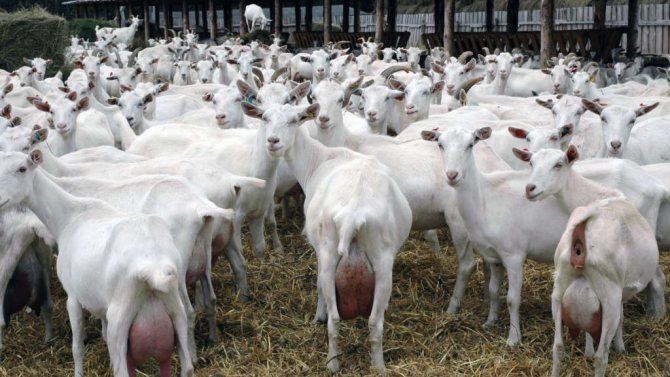

The breed is fertile, it is often used for breeding and improving the dairy characteristics of other breeds.
Reproduction rules:
- At least 200 days should elapse between the last lambing and insemination.
- If a brood goat is not available, artificial insemination is used.
- Females are launched 2 months before the goat.
- Females begin to inseminate at the age of 12 months, not earlier. The recommended age is 14-16 months.
- Special lambing rooms are not required.
With proper care, there are no problems with breeding Saanen goats.
Breeding principles:
- The mating is carried out when the female is hunting.
- After the female is covered, the goat can be removed from her.
During three months of pregnancy, the goat is fully milked. Then the frequency and volume of milk yield is gradually reduced - until lactation stops completely. The goat before lambing should gain strength.
If you do not stop milking - do not start the goat, then the kids will be born weak, and the goat will suffer.
It is important to have a good breeding goat for successful breeding. It, like milking goats, must be taken from reliable breeders. Before buying expensive purebred Zaanen goats, you should try breeding regular goats.
A Saanen goat costs the same as a cow. And if a mistake is made in the cultivation technology, large losses can be incurred.
Newborn kids are raised in two ways - they are immediately taken away, transferred to artificial feeding, or kept next to a goat up to 4 months of age.
After 4 months, the kids have a strengthened digestive system, and they are smoothly transferred to roughage.
This method reduces the milk productivity of the livestock, therefore it is rarely used.
When keeping a kid next to a goat, the number of milking days per year is 210 days. With early weaning, the lactation period is 300 days a year.
Afterword
In the absence of experience in keeping animals, one must be prepared for the fact that the most expensive purebred Zaanen goat will give significantly less milk than an ordinary village goat. Only experienced breeders can reap the full benefits of a purebred herd. It is not worth starting “agricultural. study "with expensive goats, it is better to buy a few ordinary goats for a start. By the way, this will give not only experience, but also tell you how ready the owners are to deal with such animals. It should be noted that not all owners have enough perseverance and character, goats can be very moody.
Video - Breeding Saanen Goats.
Content
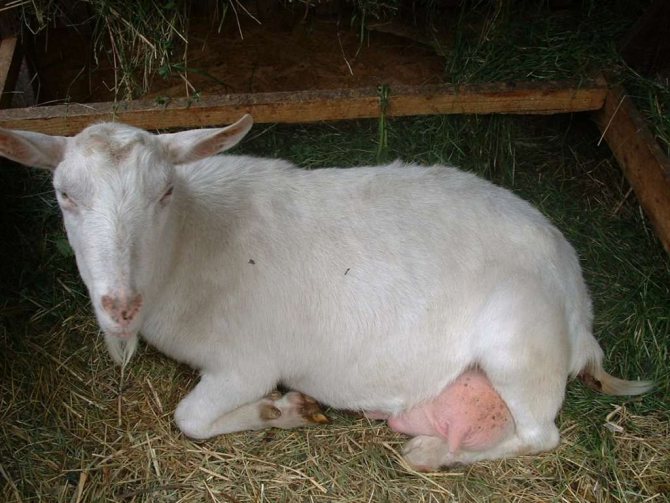

Saanen goats are kept according to stall-pasture methods. The breed adapts well to cold weather, but does not tolerate heat and dampness well - these climate features can cause the death of the entire livestock.
Zaanenets are demanding in terms of keeping conditions - in order to get good milk yield, it is necessary to create appropriate conditions for the animals.
In warm weather, the herd grazes on pastures, in cold weather it is indoors. The approximate duration of the periods: grazing - 185 days; stall - 180 days.
Stoilovoe
When kept in stalls, goats spend a lot of time in the barn. The room should be free of dampness and drafts. Goats are usually kept loose in stalls.
Content requirements:
- humidity not more than 75%;
- temperature - not lower than 0 ° С;
- a lot of natural light;
- high-quality ventilation system;
- the presence of walking in the fresh air - make a fenced area;
- the presence of straw bedding in stalls - from 50 cm thick;
- the presence of feeders and drinkers fixed on the walls;
- complete cleaning and disinfection of the barn 2 times a year.
Hooves are trimmed every six months.
One person is enough to look after the goats. The litter is changed as it gets dirty.
Biothermal processes that take place in the straw bedding lead to the generation of heat - this allows you to reduce the cost of heating the room.
Goats are not allowed to stay in stalls without a way out. They should receive regular walking:
- in frosts - 1-2 hours;
- in case of slight cold - 4-5 hours.
Benefits of walking on the street:
- metabolism improves;
- immunity increases;
- the quality of the wool improves.
The walk is canceled if:
- snowing;
- frosts are too strong;
- the thickness of the snow cover is more than 10 cm.
The barn can also be used in the summer for spending the night. It is ventilated in winter and ventilated in summer. The temperature in it should not rise above 20 ° C - the Zaanen people do not like heat.
When spring comes, animals are transferred to grazing.
Pasture
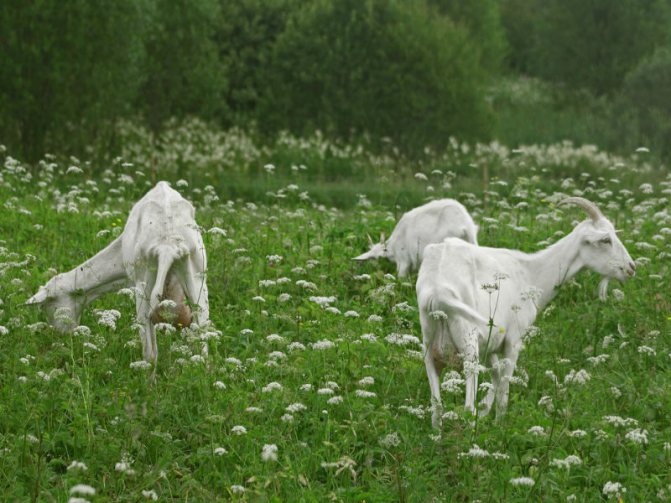

It is impossible to abruptly send the animals out to grazing - they must gradually get used to natural conditions.
The herd should not be too large, as the animals will be restless, and besides, when there are a lot of goats, it is difficult to pay attention to each one - the incidence often increases.
The recommended norm of female goats for one breeding goat is 25-50 individuals. When forming a herd, one should take into account that quantity may not always turn into quality.
Requirements for grazing:
- Open the walking period it is necessary taking into account the temperature, climate and quality of the grass in the pasture.
- Do not drop goats in wet areas - they will trample many useful plants.
- When the season just started, the herd should be released into well-lit areas, preferably on a hill.
- Releasing goats for walking, they remove the hoof horn in advance, which appears during wintering in stalls.
- The herd is driven to graze until sunrise. Only in early spring and late autumn are they driven out later, when the cold dew leaves the grass.
- Animals are contraindicated to be under the scorching sun. From 10 to 16 o'clock they take a break, driving them under the sheds.
- Goats are herbal gourmets. They will not eat grass that does not suit their taste - they choose only the most delicious and juicy. Therefore, you should not send the herd to pasture with grass that goats do not like.
- Zaanenz do not tolerate changes in atmospheric pressure. They better not graze in the rain.
- Pasture should not be given to goats at full disposal - they will quickly deplete the site. It is necessary to use the areas dosed in order to restore the grass cover.
- The optimal walking area for a dozen goats is 2.5-3 hectares. On such a site, goats can eat for about 6 days, no more.
- To visualize parcel boundaries, it is recommended to put pegs.
- It is advisable to adjust the location of the herd in relation to the sun - it should be at the back or side. If the sun is in front, it is difficult for animals to find the plants they need.
- During the stay of the animals under the canopy - it is arranged near the pasture, they can be fed with dried grass.
- Saturation time for goats on a quality pasture is 6 hours. They spend the same amount of time on "chewing gum", and at this time they settle down on the ground and rest.
- Water for the Zaanen people grazing in the pasture is given 2 times a day. If the grass is juicy and not hot, you can limit yourself to a single drink. The best time for a pasture watering hole is early morning and midday respite. In especially hot weeks, when the grass becomes rough, goats are additionally watered - 2 hours after the start of walking and 2 hours after the day's rest.
An important feature of keeping the Saanen breed is the rejection of ordinary grass. It is recommended to feed these goats with grains and legumes - they are often planted with artificial pastures.
During a walk, a goat eats an average of 6 kg, a goat - 8 kg. Resting areas should be set up to provide goats with daily rests and night rest.
The campsites are usually not fenced off, but it is recommended to install portable barriers, with the help of which temporary enclosures for counting goats are organized.
Where does the Damascus goat live?


Photo: Damascus goat shami
The animal lives exclusively at home. It should be noted that it is very difficult to find purebred representatives of this breed. They are among the most expensive goats in the world. Animals are completely undemanding to the conditions of detention. They are freedom-loving, and therefore in the warm season it is better to keep them on free grazing, if there is such an opportunity.
To keep animals during cold weather, it is necessary to prepare a home for them in advance. Its area depends on the number of heads. The room should be spacious, without drafts and dampness. The optimal area per animal is 5-8 square meters. Animals are considered to be quite thermophilic and do not tolerate cold well, which can cause serious illness. It will be best if the inside of the room is divided by partitions separately for each animal.
Another important criterion is a sufficient amount of light. The length of daylight hours for goats should be at least 9-10 hours per day. The temperature in the room where the animals are kept is not critical. It will be best if it is no more than 24-25 degrees and no less than 17-18. The largest number of goats of this breed is concentrated in the eastern countries - Syria, Lebanon, etc.
Feeding
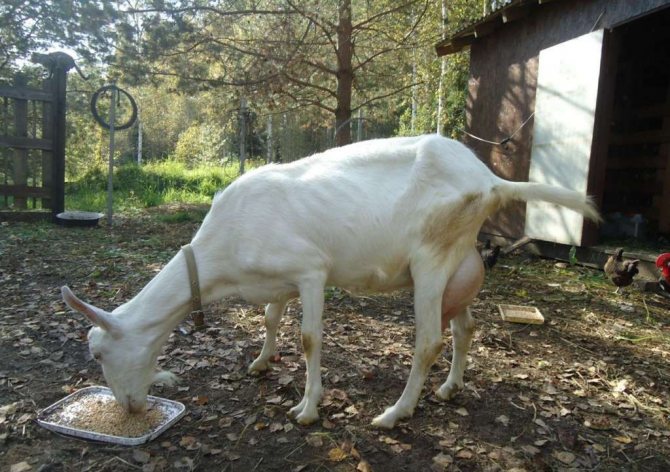

In order for goats to produce a lot of high quality milk, they need to be provided with a balanced diet.
Goat diet:
- Fresh hay is given in the morning.
- A few hours later - branches of birch, alder, willow.
- Pasture - feeding on grass.If there are trees and shrubs nearby, goats can feast on their branches and foliage.
- In the evening, they give a mash of potatoes, bran and pasture.
Animals should be accustomed to both types of feed - dry and fresh.
In order to fully assimilate food, special bacteria must be developed in the stomachs of animals - for the digestion of a particular feed.
New nutritional components are introduced into the diet gradually - to avoid diarrhea and other disruptions in the gastrointestinal tract. Learning to one type of food lasts about a week.
It is also necessary to smoothly switch from a winter diet to a summer one - the animals are given time to reorganize the body.
Daily nutritional norms
During the period of stall keeping, in order to get a milk yield of 5 liters, it is necessary to provide each goat with a complete and balanced diet.
Approximate diets of goats for stall keeping:


15 g of salt is a mandatory daily allowance. It is recommended to give feed in the following proportion:
- concentrated mixtures - 40%;
- roughage - 20%;
- green feed - 40%.
Daily hay norms for Zaanen people, taking into account age and gender:
- goat - 3 kg;
- goat - 2.2 kg;
- kid up to a year - 1 kg.
When feeding females, the reproductive phase and health status are taken into account:
- When dry, to get 1 liter of milk, a goat needs 0.8 feed units and 30 g of protein.
- During lactation, to obtain 1 liter of milk, you need 0.36 feed units and 55 g of protein.
Before starting (cessation of lactation), goats are transferred to a special nutrition system - so that the kids are born healthy and strong. The emphasis is on protein nutrition.
Here is a sample diet:
- hay - 1-1.5 kg;
- oat mixture - 4 kg;
- concentrated feed - 200 g.
Another option for a goat's diet before starting:
- hay - 1.2 kg;
- oat-pea mixture - 3 kg;
- concentrated feed - 100 g;
- pasture - unlimited.
Life span, reproduction cycles
These goats live for about 10 years, reaching puberty between 3 and 12 months. The breeding season is in the fall, with the female's cycle lasting 17 to 23 days. Estrus lasts 12 to 48 hours. Pregnancy is 148 to 156 days.
The goat sniffs the air to understand if the female is in estrus, stretches her neck and head up and wrinkles her upper lips.
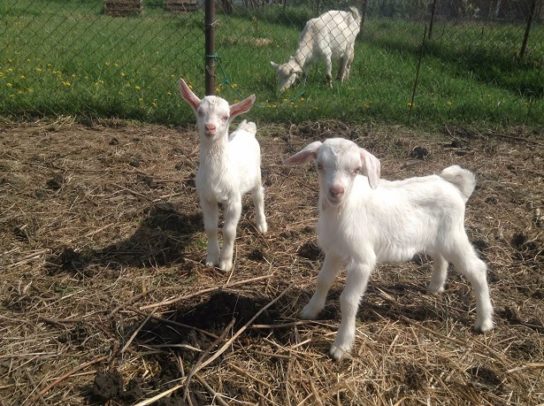

Milking goats
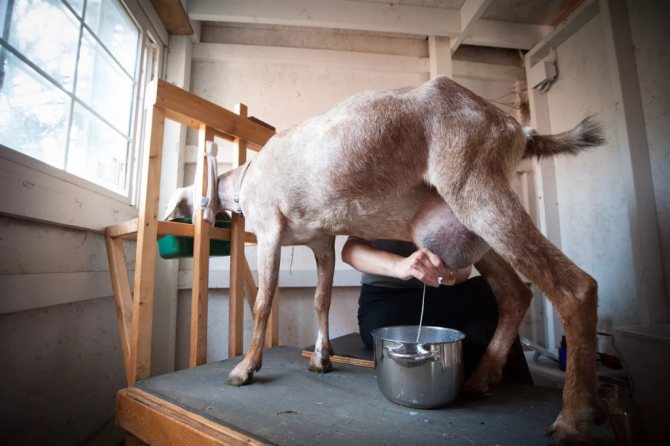

High-yielding Saanen goats can be milked using either of two methods:
- Manually. This option is suitable for small farms. Manual milking technique - holding the nipple with the index and thumb and pulling it down. For the milk to run, the movements must be repeated at a certain rhythm.
- Machine method. It is used mainly in large farms. Usually devices "Burenka" or "Belka-1" are used.
Goats quickly stop being intimidated by machine milking. Already from the third time they cease to be nervous when turning on the device.
The number of milkings is directly related to the rearing of kids:
- If the kids are transferred to artificial feeding, then the first week after lambing, the goat is milked 5 times a day, gradually the number of milkings is reduced to 3 per day.
- If sucking-milk technology is used, the female begins to milk only from the 8th week. The number of milkings is once a day. When the kids completely switch to an adult diet, the number of milkings is increased to 2 per day.
Tips for correct milking:
- The goat must be trained to stand still during milking. To do this, it is always milked in one place.
- Before milking, be sure to wash your hands. The nails should be trimmed short to avoid damaging the udder.
- You need to put food and water in front of the animal - enough to last for the entire milking time. While it is being milked, the goat will eat.
- During milking, the goat should be praised - these intelligent animals perfectly understand intonation and kind words.
- It is advisable to train the goat to stand still in advance - 3 months before lambing.
- To keep the nipples elastic, they need to be massaged regularly.
- In summer, you need to milk a goat at least three times a day - with fresh and juicy feed, lactation increases.
- Milking should be regular - then milk yield will be stable.
- In cold weather, when feed consumption is reduced, the number of milk yields can be reduced to 2 per day.
Diseases and their treatment
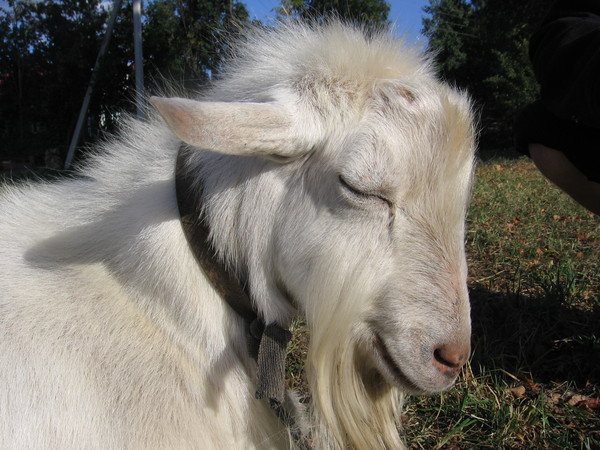

Providing quality care to the Saanen goats will minimize the risk of disease. However, it increases during lambing and the transition from stall to pasture.
To prevent illness during this period, it is recommended:
- After lambing, place the goat in a separate stall, monitoring its condition. At the first signs of lethargy, lack of appetite, you need to invite a veterinarian. Perhaps the amniotic fluid has not completely departed, and the weakened body needs treatment.
- When the transition to pasture begins, there is a risk of poisoning from inedible grasses. Goats are good at grasses, but poisonous grasses are often captured - in small quantities they are not dangerous.
Poisoning symptoms:
- vomiting;
- frequent urination;
- fast heartbeat;
- hard breath.
If several goats grazing in the pasture have similar symptoms at once, they are probably poisoned by chemicals used in agronomy.
It is important to carefully examine the area where the goats will graze before releasing them there.
The most common diseases of Saanen goats, their symptoms, treatment:
Acute tympanic scar
| Signs of the disease | How to treat? |
| bloating of the abdomen; | put a tourniquet of straw in the mouth; |
| belching; gases in the rumen | massage the abdomen by rubbing with a wet napkin; |
| lack of appetite, cessation of gum, excessive salivation; | give a solution of ammonia - 1 tsp. essences in 500 ml of water; |
Poisoning
| wash the stomach using warm water and crushed coal; |
| watered with oat broth with flax seeds. |
Hoof necrobacteriosis
|
|
Mastitis
| firm udder; | greasing the udder with lard; |
| decrease in milk production; | frequent expression of milk; |
| turning milk into flakes; | strict diet - prescribed by the veterinarian; |
Foot and mouth disease
| quarantine of the farm; |
| rinsing the mouth with antiseptic solutions; |
| vesicles on the mucous membrane; | a lightweight diet; |
A common problem in milking goats is nipple cracks. The reason is weathering. This problem usually occurs in goats that have recently lambed.
Separation of the goat from the herd will help prevent the problem - this is recommended for all goats after lambing, and careful observation.
Improper milking, coarse bedding, and injury to the udder can also provoke cracks.
Cracks are treated with a solution of boric acid - take a teaspoon of the powder and dilute in boiled warm water. Or they lubricate the cracks with antiseptic ointments, which the veterinarian will prescribe.
Prevention of cracks:
- lubricating the nipples with petroleum jelly;
- as soon as the slightest abrasions appear, immediately lubricate them with antiseptics.
If there is damage on the body of the animal, the wound is washed with potassium permanganate (a weak solution is needed), smeared with iodine, sprinkled with naphthalene, and if necessary, bandaged.
It is important to ensure the prevention of helminthiasis. To rid animals of parasites, they are given carbon tetrachloride to drink.
For prevention, deworming of all goats in the herd and dogs used by shepherds for grazing the herd is organized. One more week, after the course of treatment, it is necessary to neutralize feces.
How to care for a Zaanen goat
This is not to say that the Zaanen goats are picky and demanding in care, maintenance and breeding, but still it is necessary to create suitable conditions for the animals in order to receive good milk yield in the future. The requirements include the following criteria:
- Cleanroom for goats and goats
- Constant airing
- Regular walking, and you should not let goats out into the street if it is too cold in winter or hot in summer.
The goat's house should be equipped in such a way that the animals live comfortably and are protected as much as possible from cold, heat, wind and precipitation. It is advisable to plan a concrete floor covering during the construction of a room, and place wooden loungers on top of it. As for the milk goats, it is recommended to keep them in a separate stall. Usually they are placed in two, the area of such a room should be at least 2 sq. M. However, the Saanen goat needs a more spacious dwelling, keep this in mind when drawing up a goat's rue plan.
How to choose the right one?
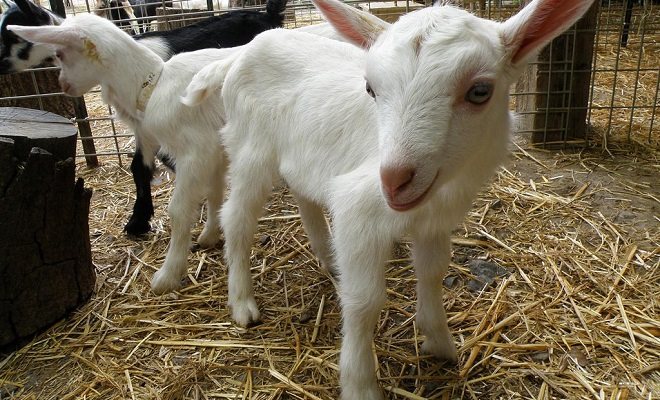

To breed Saanen goats, you need to buy producers in reliable places - at breeding farms. But for many people who want to have Swiss goats, a trip to the breeding farm is too difficult, they will have to travel very far.
Therefore, most stakeholders buy livestock from farmers. When buying goats from private farmers, we are not talking about a 100% purebred breed - no one gives guarantees here.
But knowing a few signs, you can increase your chances of acquiring a purebred individual.
When choosing Saanen goats, pay attention to the following points:
- Wool. It should be snow-white - without any shade. The presence of shades indicates an admixture of someone else's blood. Or let the seller drop the price - no one will pay for a half-breed as for a thoroughbred goat. You should also pay attention to the villi - they should be short and shiny. If the coat is dull, matte, the animal is probably sick with something.
- Back. It should be flat. If the animal shows signs of "hump" or "concavity" - it is not a Saanen breed.
- Height at the withers. In the Zaanen, it is at least 75 cm at the age of one year. Growth may be less - if the conditions of detention were violated. Such animals, even purebred ones, will yield lower milk yield.
- Age. Do not take a goat after the 4th lactation. From this age, the decline in milk yield begins.
- Milk. It should not have any specific odor. If the milk smells, the animal is not well looked after. Milk usually smells when goats are kept together with goats.
To choose a goat, and even purebred, you need to have at least some experience in breeding these animals. An inexperienced buyer can be sold under the guise of a Saanen individual, the most common white goat.
Information on the note
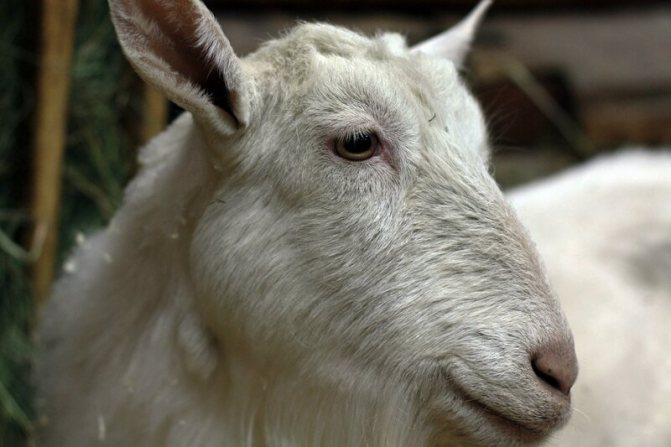

Useful information for novice breeders:
- Goats will not pick up food on the bed. Unless they get very hungry. But it is impossible for animals to reach such a state. To prevent the feed from falling to the floor, you need to make the right feeders - they should be convenient for goats and nothing should fall out of them.
- A slight decrease in the temperature in the stall is not critical, but the presence of drafts is unacceptable. Drafts are a common cause of disease in Saanen goats.
- The stall must be clean and dry, you need to change the litter every day.
- Artificial lighting should be turned on during the winter season. Daylight hours should be at least 10 hours.
- The diet needs to be adjusted - you cannot be limited to one recipe or nutritional norm. Everything is very individual, feed and norms change depending on age, type of maintenance, lactation period, gender and other factors. You have to either increase the amount of succulent feed, or vice versa, reduce it by adding dry hay to the diet.
- Overeating, like malnutrition, is harmful to Saanen goats. You need to control their food while walking.So that the goats do not trample the pasture, you can keep them in the corral, and feed them with feed, cutting down from the plot. If there is a lot of pasture land, goats are simply driven from place to place more often.
To take full advantage of the high yielding Swiss goats, you have to take care of the right conditions.
If purebred Zaanens are not provided with a balanced diet, walking and a warm, clean barn, they will not produce more milk than an ordinary goat.
Views
The Saanen animals are classified as domestic goats (Capra hircus), which according to the biological classifier belongs to the genus of ibex (Capra). As a result of selection, the Saanen breed was divided into several lines. The most famous are:
- Swiss Saanen goat;
- romanian white banat
- American Saanen goat;
- Saanen Nubian goats;
- British Saanen goat;
- New Zealand or sable goat;
- Russian white goat.
There are several local varieties of the Saanen goat in Switzerland. Unlike the canonical breed, they are smaller, weigh about 50 kg. The hide may not be pure white. The main advantage of local varieties of the Saanen breed is adaptation to local conditions.
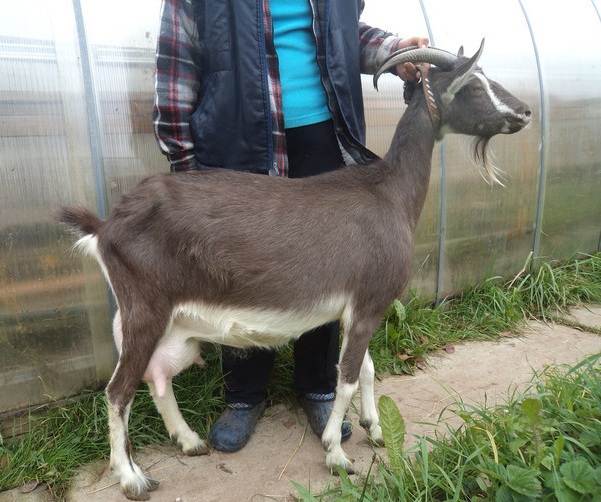

Saanen goat chocolate color, another name is sable
The standard color for Saanen goats is white. In New Zealand, animals are cultivated in which the gene responsible for the brown color prevails. As a result, New Zealand goats are not only white, but also brown, brown, black. In 2005, this breed line was recognized by livestock breeders.

